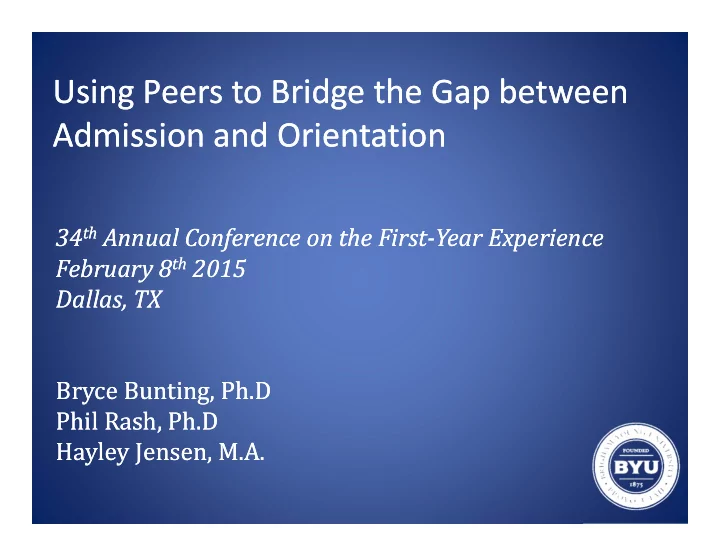

Using Peers to Bridge the Gap between Using Peers to Bridge the Gap between Admission and Orientation Admission and Orientation 34 th Annual Conference on the First ‐ Year Experience 34 th Annual Conference on the First ‐ Year Experience February 8 th 2015 February 8 th 2015 Dallas, TX Dallas, TX Bryce Bunting, Ph.D Bryce Bunting, Ph.D Phil Rash, Ph.D Phil Rash, Ph.D Hayley Jensen, M.A. Hayley Jensen, M.A.
A quick survey to get things started . . . • Groups of 2 – 3 – When are your first ‐ year students admitted? – What are the first ‐ year programs or interventions you have in place? – When do they take place?
Framing the Problem: Navigating the Summer Months • Nationally – Summer Melt (Castleman & Page, 2014) • BYU – “The great silence”
Our Intervention • Transition Mentoring – Description – Objectives • Extend a personal welcome • Provide an immediate role induction to mentoring • Establish mentoring as a reliable point of contact • Communicate important information
Intervention Cont. • Interactions, Timeline & Training – Welcome email (late Feb. – early Mar.) – Phone call (end of mar.) – Registration email (end of May) – Hand ‐ off email (August)
Our Research • Method and Scope – Qualtrics survey measuring perception of, and satisfaction with, recent transition mentoring experience – 710 responses (59% completion rate)
Key Findings • Registration and course selection remain the top concerns • Personal connection is key • Students do not always understand the mentor role * Increased student meetings
Recommendations • Continue support for registration, class selection, housing and financial aid • Establish a more personal connection between students and mentors. • Clarify the mentor role • Mentor turnover
Challenges & Next Steps • Increase in the number of new students • Creating a mentoring “culture” • Quality control • Mentor attrition/availability/ remote mentoring • Clarifying the role of a transition mentor • Improving a sense of personal connection • Technology and communication • The “hand ‐ off”
Contact Information: Bryce Bunting Associate Director, First ‐ Year Mentoring Brigham Young University bryce_bunting@byu.edu Phil Rash Director, First ‐ Year Mentoring Brigham Young University phil_rash@byu.edu Hayley Jensen Peer Mentor Specialist, First ‐ Year Mentoring Brigham Young University hayley_jensen@byu.edu
References Castleman, B. L., & Page, L.C. (2014). A trickle or a torrent? Understanding the extent of summer “melt” among college ‐ intending high school graduates. Social Science Quarterly, 95 (1), 202 – 220.
Recommend
More recommend